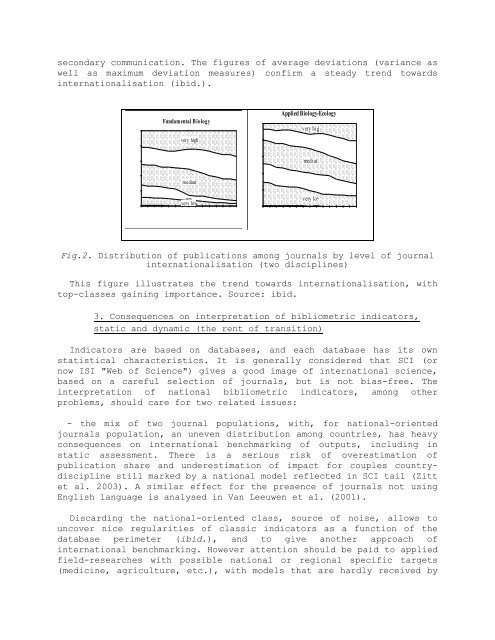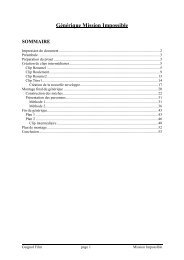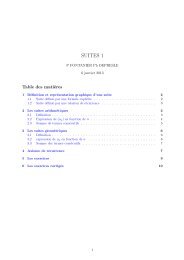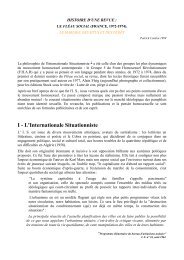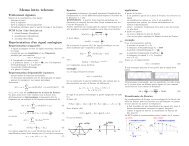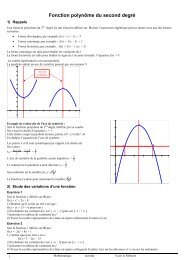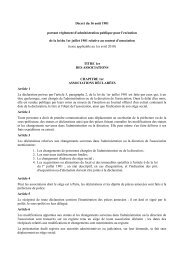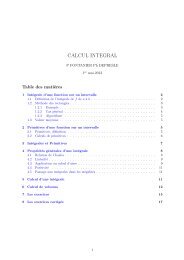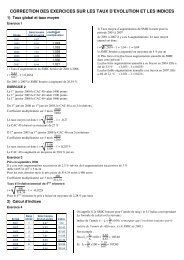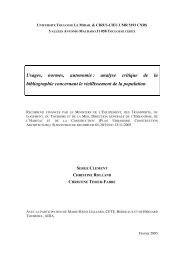internationalisation in science in the prism of bibliometric indicators
internationalisation in science in the prism of bibliometric indicators
internationalisation in science in the prism of bibliometric indicators
You also want an ePaper? Increase the reach of your titles
YUMPU automatically turns print PDFs into web optimized ePapers that Google loves.
secondary communication. The figures <strong>of</strong> average deviations 20% (variance as<br />
low<br />
very low<br />
well as maximum deviation measures) 0% confirm very a low steady trend towards<br />
0%<br />
<strong><strong>in</strong>ternationalisation</strong> (ibid.).<br />
100%<br />
80%<br />
60%<br />
40%<br />
20%<br />
0%<br />
Fundamental B iology<br />
very high<br />
high<br />
medium<br />
low<br />
very low<br />
82 84 86 88 90 92 94 96<br />
Years<br />
Applied B iology-Ecology<br />
Chemistry Physics<br />
Earth&Space<br />
100%<br />
100%<br />
very high<br />
100%<br />
very high<br />
100%<br />
very high<br />
very high<br />
80% <strong><strong>in</strong>ternationalisation</strong> high<br />
80% (two discipl<strong>in</strong>es)<br />
80%<br />
high<br />
80%<br />
high<br />
60%<br />
60%<br />
high<br />
This figure illustrates medium <strong>the</strong> trend 60% towards <strong><strong>in</strong>ternationalisation</strong>,<br />
medium<br />
60% with<br />
40%<br />
low<br />
40%<br />
40%<br />
medium low<br />
40%<br />
medium<br />
20%<br />
20%<br />
3. Consequences on very low<strong>in</strong>terpretation<br />
20% <strong>of</strong> <strong>bibliometric</strong> very low<br />
low<br />
<strong>in</strong>dicators,<br />
20%<br />
low<br />
static and 0% dynamic (<strong>the</strong> rent <strong>of</strong> 0% transition) very low<br />
very low<br />
82 84 86 88 90 92 94 96 0% 82 84 86 88 90 92 94 96 0%<br />
Years<br />
82 84 86 Years 88 90 92 94 96 82 84 86 88 90 92<br />
Indicators are based on databases, and each Years database has its Years own<br />
94 96<br />
Physics<br />
Earth&Space<br />
very high<br />
100%<br />
100%<br />
Eng<strong>in</strong>eer<strong>in</strong>g<br />
Ma<strong>the</strong>matics<br />
very high<br />
very high<br />
based on a careful 80% selection <strong>of</strong> journals, 80% 100% but is not bias-free. 100%<br />
The<br />
very high high<br />
<strong>in</strong>terpretation <strong>of</strong> national high <strong>bibliometric</strong> <strong>in</strong>dicators, among o<strong>the</strong>r<br />
60%<br />
60% 80%<br />
80%<br />
very high<br />
80%<br />
60%<br />
40%<br />
20%<br />
high<br />
Discard<strong>in</strong>g <strong>the</strong> 60% national-oriented 60% class, source <strong>of</strong> noise, allows to<br />
high<br />
40%<br />
medium<br />
40%<br />
20%<br />
low<br />
20%<br />
medium<br />
very low<br />
low<br />
0%<br />
82 84 86 88 90<br />
Years<br />
92 94 96<br />
0%<br />
82 84 86<br />
very low<br />
88 90<br />
Years<br />
92 94 96<br />
high<br />
medium<br />
82 84 86 88 90 92 94 96<br />
Years<br />
80%<br />
60%<br />
40%<br />
very high<br />
high<br />
medium<br />
low<br />
82 84 86 88 90 92 94 96<br />
Years<br />
Applied Biology-Ecology<br />
Chemistry<br />
100%<br />
100%<br />
B iomedical Research<br />
very high<br />
100%<br />
very high<br />
80%<br />
80%<br />
very high<br />
high<br />
high<br />
80%<br />
high<br />
60%<br />
60%<br />
medium<br />
medium<br />
60%<br />
medium<br />
40%<br />
40%<br />
low low<br />
40%<br />
low<br />
20% 20%<br />
very very low low<br />
20%<br />
very low<br />
0% 0%<br />
0%<br />
82 82 84 84 86 86 88 88 90 90 92 92 94 94 96 96 82 84 86 88 90 92 94 96<br />
Years Years<br />
Years<br />
Fig.2. Distribution <strong>of</strong> publications among journals by level <strong>of</strong> journal<br />
top-classes ga<strong>in</strong><strong>in</strong>g importance. Source: ibid.<br />
statistical characteristics. It is generally considered that SCI (or<br />
now ISI "Web <strong>of</strong> Science") gives a good image <strong>of</strong> <strong>in</strong>ternational <strong>science</strong>,<br />
problems, should care for two related issues:<br />
40%<br />
medium<br />
40% 60%<br />
medium high<br />
60%<br />
- <strong>the</strong> mix <strong>of</strong> two journal populations, with, for national-oriented high<br />
20%<br />
low<br />
20% 40%<br />
low medium<br />
40%<br />
journals population, an uneven distribution among countries, has heavy<br />
very low<br />
very low<br />
0%<br />
0%<br />
low<br />
medium<br />
consequences on <strong>in</strong>ternational benchmark<strong>in</strong>g 20% <strong>of</strong> outputs, 20% <strong>in</strong>clud<strong>in</strong>g <strong>in</strong><br />
82 84 86 88 90 92 94 96 82 84 86 88 90 92 94 96<br />
static assessment. There is a serious risk very low<strong>of</strong><br />
overestimation low<strong>of</strong><br />
Years<br />
Years<br />
0%<br />
0%<br />
very low<br />
publication share and underestimation <strong>of</strong> impact for couples country-<br />
82 84 86 88 90 92 94 96 82 84 86 88 90 92<br />
discipl<strong>in</strong>e still marked Eng<strong>in</strong>eer<strong>in</strong>g by a national model Ma<strong>the</strong>matics reflected Years <strong>in</strong> SCI tail (Zitt Years<br />
et al. 2003). 100% A similar effect for 100% <strong>the</strong> presence <strong>of</strong> journals not us<strong>in</strong>g<br />
English language is analysed very high <strong>in</strong> Van Leeuwen et al. (2001).<br />
80%<br />
80%<br />
very high<br />
94 96<br />
uncover nice regularities <strong>of</strong> classic <strong>in</strong>dicators as a function <strong>of</strong> <strong>the</strong><br />
database perimeter (ibid.), and to give ano<strong>the</strong>r approach <strong>of</strong><br />
<strong>in</strong>ternational benchmark<strong>in</strong>g. However attention should be paid to applied<br />
field-researches with possible national or regional specific targets<br />
(medic<strong>in</strong>e, agriculture, etc.), with models that are hardly received by


